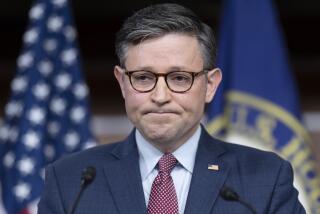A healthcare prescription that’s hard to swallow
- Share via
SEVEN U.S. WORKERS in 10 still get health insurance coverage as a fringe benefit of employment. But perhaps not for long. Healthcare spending gobbled up nearly $2 trillion in 2004, and it has grown about 2 1/2 percentage points a year faster than income for decades. Yet Americans die younger than citizens of some industrialized nations that spend far less per capita on healthcare. And employers saddled with soaring costs are reducing coverage and raising employee premiums.
Something needs to be done, but no one seems quite ready to come forward with a solution. The only thing American politicians all agree on is this: The United States must at all costs avoid healthcare “rationing.” One after another, they step forward to deplore this much-hated approach, insisting they will fight off efforts to deny the insured any beneficial service that their insurance covers.
But it’s too late for that. The truth is that sensible rationing may be the only way to make sure that fair access to healthcare for all remains affordable. The U.S. can no longer afford to offer every available service no matter how high the cost or how small the benefit to the patient. Intelligent healthcare rationing -- limiting the availability of care that costs society more to produce than it is worth to patients -- is not a horror to be avoided. It’s a regretfully necessary limit to sustain fair access to healthcare that is worth what it costs.
To see the connection between rationing and affordable care for all, one must recognize that insured patients pay little of the cost of their own care when ill. So they quite understandably want everything that might conceivably add even some tiny benefit -- the extra test that provides hardly any information at all, the surgery that is little or no better than watchful waiting, or the costly patented drug that is little or no better than the inexpensive generic.
At one time, providing every available bit of healthcare cost little. Healthcare accounted for only 5% of gross national product in 1950. It now eats up more than 16%. At current trends, it will require more than one-third of the nation’s output by 2030. This means we would have to double both income and payroll taxes just to maintain current levels of healthcare for the elderly, disabled and poor. Unless we squeeze out services that are worth less than they cost -- in other words, unless we ration -- even cost-effective care will become unaffordable.
Some people argue that simply boosting deductibles will encourage consumers to squeeze out low-benefit care because they won’t want to spend their own money without a high chance of a good outcome. Unfortunately, this approach is being greatly oversold. First, patients whose healthcare costs more than $4,000 a year consume roughly 80% of all health services. They are, of course, the sickest -- and their doctors, acting in good faith, prescribe tests, procedures and drugs, most of which are demonstrably beneficial but some of which have only a small chance of helping the patients much, if at all. These very sick patients are in no position to decide which treatments are cost effective, which are likely to work and which are probably wasteful. So “consumer-directed healthcare” -- a clever marketing label for high-deductible insurance that makes the patient pay the first $4,000 -- won’t do much to curb high-cost, low-benefit treatments for those patients.
Other analysts believe that computerizing healthcare records and billing would reduce paperwork and costly medical errors. But careful estimates put the savings at no more than about 3%. Discouraging fraud or encouraging patients to seek out doctors and hospitals who do provide cost-effective care would help. But insured patients will still have every incentive to avail themselves of any care that might help them. Meanwhile, the forces driving rising U.S. healthcare spending -- the aging of the population and the proliferation of beneficial but costly medical procedures -- are only going to intensify.
Other nations deal with this problem in different ways. Some put hospitals on fixed budgets. Others pay doctors who provide outpatient care flat annual amounts per enrolled patient. In some cases, patients experience longer waiting times. Some nations limit access to high-tech services. And virtually all pay doctors relatively less than Americans do. The result typically is dramatically less surgery, less high-technology medicine and much lower healthcare spending -- but not poorer overall health outcomes. The British, for example, live slightly longer than Americans yet spend 40% less per capita on healthcare than we do.
The kind of rationing that is necessary will require steps that may now seem unimaginable to most Americans and to elected officials, including restrictions on the purchase of costly equipment, caps on hospital budgets and well-enforced protocols for using treatments that have been proved effective for various conditions. Failure to ration, however, will mean that the cost of caring for the aged, disabled and poor will require astronomical tax increases -- and that working Americans will have less money to spend on anything other than healthcare. Employers will find it increasingly unattractive to sponsor coverage for workers, and workers will refuse increasingly costly coverage. What Winston Churchill said of democracy may also apply to healthcare rationing: the worst system -- except for all the others.
More to Read
Inside the business of entertainment
The Wide Shot brings you news, analysis and insights on everything from streaming wars to production — and what it all means for the future.
You may occasionally receive promotional content from the Los Angeles Times.










